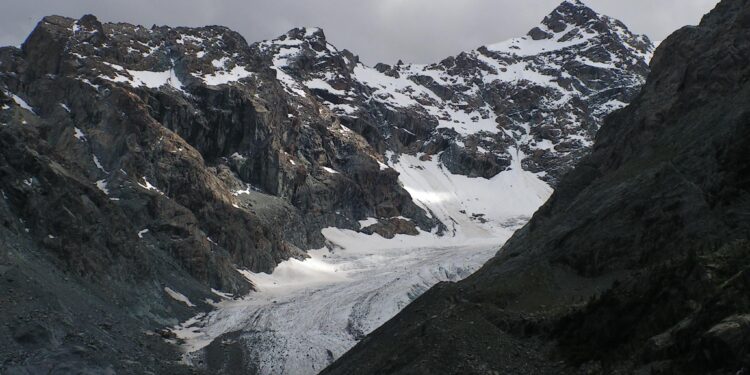The Ventina Glacier in Italy has receded to such an extent that geologists have been forced to abandon on-site monitoring, resorting instead to remote observation methods. Once a prominent feature of the Alps, the glacier’s dramatic melting underscores the accelerating impact of climate change on natural landmarks. Researchers are now relying on satellite imagery and aerial surveys to track the glacier’s ongoing transformation, highlighting growing concerns over the environmental and economic consequences for the region.
Italy’s Ventina Glacier Faces Unprecedented Melting Crisis
The Ventina Glacier, once a majestic and sprawling ice mass nestled in the Italian Alps, has now diminished to such an extent that geologists are forced to rely solely on remote monitoring technologies. This unprecedented melting is attributed to a combination of rising global temperatures and prolonged heatwaves that have accelerated ice loss over the past decade. Scientists emphasize that the rapid retreat not only threatens the glacier’s existence but also disrupts local ecosystems and water supplies dependent on the seasonal melt.
Key figures highlighting the glacier’s decline:
- Over 60% reduction in glacier volume since 1980
- Continuous negative mass balance recorded for 12 consecutive years
- Average summer temperatures increasing by 1.5¬įC in the region
- Remote sensing now primary tool for tracking changes
| Year | Glacier Surface Area (km²) | Measured Ice Thickness (m) |
|---|---|---|
| 1980 | 3.2 | 40 |
| 2000 | 2.1 | 25 |
| 2023 | 1.1 | 10 |
Geologists Turn to Remote Monitoring to Track Rapid Ice Loss
Scientists studying the Ventina glacier in Italy have witnessed unprecedented levels of ice loss, forcing them to abandon traditional onsite measurements in favor of remote technologies. Utilizing satellite imaging, drones, and ground-based sensors, geologists are now able to monitor changes in the glacier’s mass and movement from afar. This shift is crucial as the rapidly retreating ice poses significant challenges to field research, with unstable terrain and dangerous crevasses making physical access increasingly impossible.
Key methods used for remote monitoring include:
- High-resolution satellite imagery for tracking surface changes
- Unmanned aerial vehicles (UAVs) equipped with LiDAR and thermal cameras
- Automated weather stations measuring temperature and snowfall
- GPS units embedded in remaining ice patches to detect glacial shifts
| Monitoring Tool | Data Collected | Purpose |
|---|---|---|
| Satellite Imagery | Surface area, melt patterns | Detect seasonal variations and long-term retreat |
| Drones (UAVs) | 3D mapping, thermal data | Detailed glacier morphology and melt hotspots |
| Weather Stations | Temperature, humidity, snowfall | Correlate climatic conditions with ice loss |
| GPS Sensors | Movement velocity | Monitor dynamic shifts and crevasse formation |
Urgent Calls for Enhanced Climate Action to Protect Alpine Glaciers
Italy’s Ventina glacier, once a robust emblem of the Alpine ice masses, has diminished at such an accelerated rate that geologists are now forced to monitor its condition exclusively through remote sensing technologies. This shift underscores a stark reality: direct access is no longer viable due to unstable terrain and vastly reduced ice coverage. Satellite imagery and drone surveillance have become critical tools for tracking the glacier’s retreat, offering limited but vital data to understand and predict the consequences of ongoing climatic shifts.
Experts emphasize several urgent concerns in response to this alarming decline:
- Rapidly shrinking freshwater reserves impacting both ecosystems and human consumption.
- Increased risk of landslides and rockfalls as ice-bound supports weaken.
- Disruption of local tourism and economies reliant on glacier-based activities.
- Global implications for sea-level rise due to cumulative glacier melt.
| Year | Glacier Mass Loss (million m³) | Monitoring Method | |||||||
|---|---|---|---|---|---|---|---|---|---|
| 2010 | 4.5 | On-site surveys | |||||||
| 2018 | 12.3 | Mixed (field + remote) | |||||||
| 2023 |
| Year | Glacier Mass Loss (million m³) | Monitoring Method |
|---|---|---|
| 2010 | 4.5 | On-site surveys |
| 2018 | 12.3 | In Summary The rapid retreat of Italy’s Ventina glacier underscores the tangible impact of climate change on the Alpine environment. With on-site monitoring now rendered impossible, scientists must rely on remote technologies to track the glacier’s ongoing transformation. This shift not only highlights the challenges of studying vanishing natural landmarks but also serves as a stark reminder of the urgent need for global climate action to preserve fragile ecosystems before they disappear entirely. ADVERTISEMENT |
















